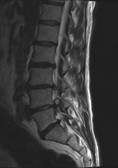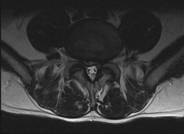|
|||||||||||||||||||||
A 45-year-old porter complained of low back pain and right leg pain a few hours after lifting heavy suitcases. The pain was accompanied by numbness along the side of the right leg as well as weakness in his right leg. He could not completely lift his right foot (“foot drop”) and it would drag along the ground as he walked. He was given pain relievers, which lessened the pain somewhat, but his right leg weakness and numbness did not improve even after 3 weeks. On examination, the patient was noted to be limping and dragging his right foot. His movements were slow and careful so as not to aggravate the leg pain. The strength of the muscles of the right foot was normal except for upturning of the right ankle and toes, which was slightly weaker. There was numbness along the right side of the leg down to the top of the foot. When the doctor raised his right leg while he was lying down on the examination table, he experienced a sharp, “electric current-like” pain running down his right leg. An MRI of the lumbosacral spine (lower back) was done, which showed a disc herniation at the L4L5 level on the right side. Discs are flat structures sandwiched between the vertebrae (bones of the spine) and act as cushions or shock absorbers of the spine. A disc herniation occurs when the disc bulges out of its normal position and causes compression of the nerve root, which in turn causes symptoms such as pain, weakness, and numbness. In some cases, they may also cause problems with bladder and bowel function. Lumbar (lower back) disc herniations are usually treated conservatively at the start, but certain cases of lumbar disc herniations require surgery to remove the disc and relieve the nerve compression. Because this patient had persistent leg weakness, surgery was recommended. He underwent laminotomy (removal of part of the bone of the spine) and discectomy of the L4L5 disc. During the operation, a large disc fragment was seen to be compressing the nerve, and this was removed without any problems. After the surgery, the patient noted an almost complete disappearance of his right leg pain. There was still numbness and weakness in his right leg but these gradually improved over the next few months. |
|
|
|
|
|||||||||||||||||

